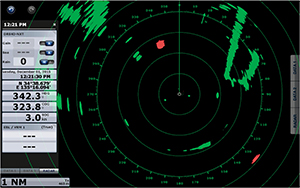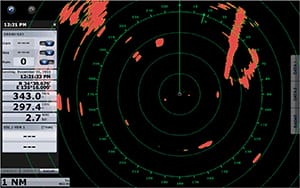One of the latest features of marine radar is so-called “Doppler radar.” These models make use of the Doppler effect to determine target motion relative to the radar. Radars like Furuno’s DRS4D-NXT UHD and Garmin’s GMR Fantom can show whether another vessel is moving toward your boat via the way the object is displayed on the screen. How do these radars work and what value are they to voyagers?
We’ve all experienced the Doppler effect with a fire truck siren, for example. The sound is shifted higher on approach and then lower after it passes.
One of the most influential devices to make use of this property was Transit, the original Navy satellite navigation system. Transit satellites were in low polar orbits and as the satellite approached a user’s satnav receiver, the received signal was shifted higher and after the satellite passed over and was moving away, the frequency went lower. Using this Doppler shift info, plus the known orbit of the satellite and some heavy-duty math, the receiver could calculate its position. This system set the stage for GPS.
The effect is also used by police “speed trap” radars to determine the speed of an approaching vehicle. The radar gun transmits at a set frequency and if the vehicle is moving toward the radar, the frequency is shifted higher. The shift is the speed of the car.
These new radars from Furuno and Garmin can determine both the range and the speed (and bearing, too — based on scanner position) of the target relative to the radar.
 |
|
The Target Analyzer is turned on and two vessels in red are approaching. |
Both magnetron-equipped and solid-state radars transmit pulses and then go silent while listening for return echoes bouncing back from any target. As discussed above, if the target is moving toward you, the frequency is shifted higher. Furuno’s DRS4D-NXT UHD has a function called “Target Analyzer” that notes any Doppler shift of the returned echoes and translates that to the screen. If a target is stationary or moving away, it is displayed green. If it is heading toward your boat, it is shown in red. For the GMR Fantom, Garmin calls the Doppler function “MotionScope” and shows closing targets in red with a blue trail.
Since determining Doppler shift is a matter of comparing the transmitted frequency to the frequency of the returned echoes, why haven’t small boat radars been providing us with Doppler capability all along?
The answer lies in the source of the microwave pulses. The Furuno DRS4D-NXT UHD and the Garmin GMR Fantom both use solid-state circuits instead of the traditional cavity magnetron, which is an analog vacuum tube.
“With a solid-state transmitter, the outgoing frequency pulses are precisely known,” said Eric Kunz, senior product manager at Furuno. “With magnetron transmitters, the outgoing frequency is not as consistent as with solid state, which makes Doppler signal processing much less reliable and difficult with a magnetron transmitter.”
The ability of solid-state transmitters to send a precise frequency is what helps make the new Doppler radars possible. The result for voyagers is heightened situational awareness — voyagers need only look at the radar to get a quick idea of closing vessels.

